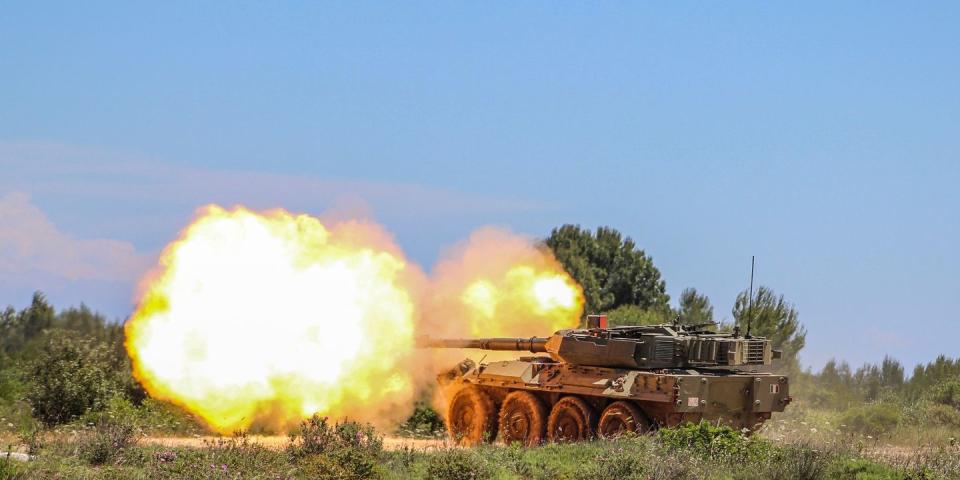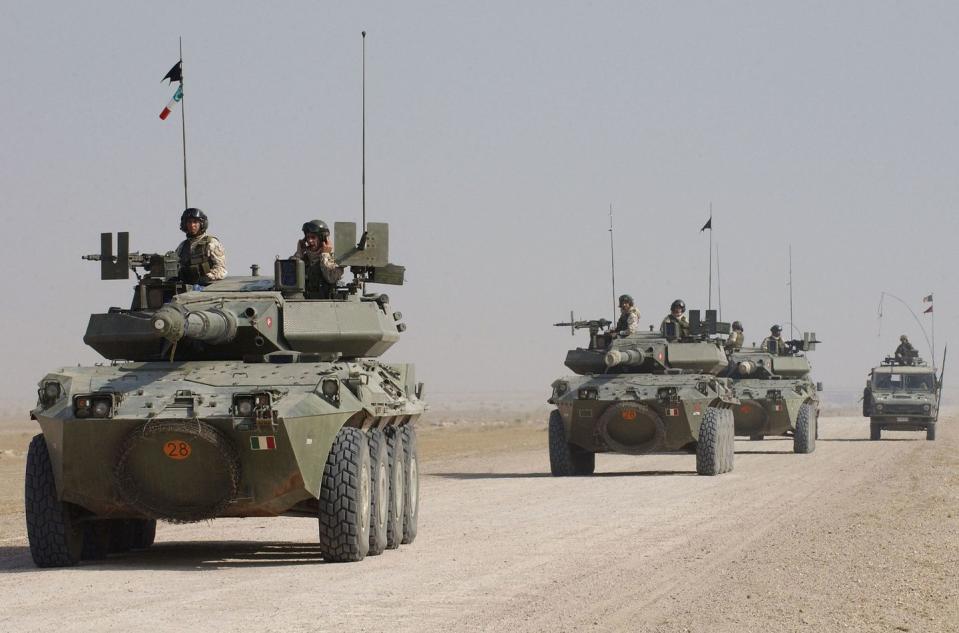Italy May Secretly Be Sending Its Tank Hunters to Ukraine

Rumors have flown on social media speculating—based on fragmentary evidence—that Rome may be “secretly” delivering some of its retiring B1 Centauro tank-destroyers to Ukraine. These nimble eight-wheeled armored cars have firepower comparable to the Leopard 1 tanks also entering Ukrainian service.
The rumors were linked to footage of a train in Caserta (near Naples in southern Italy) transporting at least four Centauros north, followed by Iveco VM90 military trucks.
Italy secretly transferred a batch of B1 Centauro wheeled tank destroyers to Ukraine, armed with Oto Melara 105 mm/52 rifled gun. pic.twitter.com/OwDBnMGJDa
— Clash Report (@clashreport) May 20, 2023
But that’s hardly proof that those B1s were bound for Ukraine, rather than for transport to an Italian base or international exercise. Convoys transporting vehicles for NATO exercises have been mistaken for aid to Ukraine before. And, notably, the lead vehicle on the train still has an Italian flag on its rear hull. Even the video’s date is unclear.
Those in support of the rumor argue that Rome has a policy of not publicizing its military assistance to Ukraine, which has been sustained in both the preceding center-left Draghi administration and the current far-right Meloni government.
Despite the policy, Italian arms transfers to Ukraine are known to include different kinds of air defense batteries and radars. These include the powerful SAMP/T system built by France, an estimated 60 or so M109L self-propelled howitzers, valuable PzH-2000 and M270A1 long-range artillery systems, heavy mortars and FH70 towed howitzers, and various trucks, infantry weapons, and other gear.
The B1 Centauro has long been seen as a plausible donation for Ukraine, as the Italian Army is replacing the 259 B1s in its nine cavalry regiments with harder-hitting Centauro IIs. It’s alleged that the Centauros on the train were refurbished in the same facility used to prepare M109Ls that were given to Ukraine.
Overall, though, the present rumors are too thinly sourced to be afforded much confidence. Nonetheless, as the Italian Army is retiring the type, it’s still possible that the Centauros may end up in Ukrainian service sooner or later.
Like the French AMX-10RC armored cars entering service with Ukraine, they would be at risk to many tank-killing weapons at the frontline. However, they could provide effective, accurate, and highly mobile fire support for operations along roads and relatively open ground—of which there is plenty in Ukraine.
If Centauros end up seeing combat in Ukraine, it will be under very different circumstances than their first frantic engagement 30 years earlier known as—we are not making this up—the Battle of Checkpoint Pasta.
Italy’s Tank-Hunting Armored Car
Italy’s armored cars and self-propelled guns were considered better than its tanks during World War II. The B1 Centauro continues the legacy of both. Like Japan’s Type 16 Maneuver Combat Vehicle, it combines the firepower of a tank with lighter armor and wheels instead of tracks, making it easier to rapidly airlift further afield.

Around 500 Centauros were jointly built by Iveco Fiat (the hull) and Oto Melara (the turret and gun) between 1991 and 2006. 250 Freccia infantry fighting vehicles based on the hull were also built. Spain operates 84 Centauros in its 2nd Castillejos Cavalry Brigade and could, hypothetically, piggyback onto an Italian donation. The U.S. and, ironically, Russia also have studied procuring Centauros in the past.
While too lightly protected for breakthrough operations expected of main battle tanks, such heavy armored cars can serve as highly mobile ‘assault guns’, providing tank-level direct fire support to infantry by knocking out fortified positions and armored vehicles at a standoff distance and remaining protected from small arms and shrapnel.
The Centauro’s 520-horsepower turbocharged diesel engine allows the 26-ton vehicle to roll down roads at a spritely 67 miles per hour. It’s manually-loaded OTO-Melara 105-millimeter 52-caliber rifled gun is optimized for minimal recoil, and based on the widely used British L7 gun used in various incarnations on the Centurion, Patton and Leopard 1 tanks.
This stabilized weapon has better penetration than the same-diameter medium-pressure gun on the French AMX-10RC, despite still falling behind the 120-millimeter gun on modern Western main battle tanks. It can still can defeat Russian frontal tank armor if equipped with the latest 105-millimeter fin-stabilized discarding sabot shells.

In truth, tank duels are more often won by the side that spots and shoots first. Here the Centauro is well-prepared, using the same TURMS digital fire control system used on Italy’s C1 Ariete main battle tanks, with stabilized day/thermal night sights for both gunner and commander to allow for targeting on the move. Secondary armament is provided in the form of coaxial and turret-top 7.62-millimeter machine guns.
The Centauro’s welded steel armor provides all-around protection against 14.5-millimeter heavy machine gun fire, and against 23-millimeter cannon shells from the front. However, most Italian Army Centauros have bolt-on armor installed to protect against the 30-millimeter guns on Russian BMP-2 fighting vehicles, which would substantially enhance their survivability in Ukraine.
Italy has also sometimes fitted ROMOR-A explosive reactive armor to Centauros that give it a chance to survive hits from rocket-propelled grenades. For a good measure, the B1’s front-mounted engine may also shield the crew from penetrating hits.
The Italian Army’s new Centauro IIs are most known for their more powerful 120-millimeter guns, but also feature a V-shaped hull and reinforced seating for better mine resistance, and support for a remote-control turret machinegun (7.62, 12.7 or 40-millimeter caliber).
Some Centauros also have a laser-warning system to alert the crew if they’re being painted by the targeting lasers used for guidance by Russian anti-tank missiles—giving them a chance to discharge smoke grenades and move out of line of sight.
Battle of Checkpoint Pasta
Conceived in the 1980s to rapidly engage invading Soviet tanks by leveraging Italy’s highway network, Centauros have invariably fought very different foes.
In Iraq, they saw action as part of the Italian contingent assisting the U.S. occupation from 2003-2006 around the city of Nasiriyah—particularly on April 6, 2004, when the 11th Bersaglieri infantry regiment were assigned to drive away Shia Mahdi militia, denying access to two of the city’s three key bridges (the attack on the third was canceled due to the presence of numerous women and children).

Centauros from a squadron of the 3rd Savoia Cavalry Regiment gave covering fire, blowing apart a restaurant from which sniper and rocket-propelled grenade fire were raking the Bersaglieri. After four hours of fighting, the militia agreed to cede the bridge to the control of Iraqi police.
Italian Centauros have also been favored for patrols and convoy escort missions in UN peacekeeping operations in the former Yugoslavia, and continue to be so to this day in Lebanon (UNIFIL)—fighting which also has included Spanish Army Centauros.

But the Centauro first saw combat supporting far more turbulent UN operations in Somalia in 1993. Forces were seeking to suppress the marauding forces of Somali warlord Mohamed Farah Aided, who absconded with food aid deliveries meant to relieve a devastating famine.
Their most famous engagement was the Battle of Checkpoint Pasta on July 2, 1993 which took place near an abandoned Barilla pasta factory and, in many ways, pre-figured the notorious Battle of Mogadishu (depicted in the film Black Hawk Down) the following April.
Italy’s involvement in a pasta-adjacent battle was not entirely coincidental, as its role in the humanitarian operation was related to its colonial past in Somalia (which explains the popularity of spaghetti adapted into Somali cuisine).
The incident began when several Italian VCC-1 Camilliano armored personnel carriers (an Italian spinoff of the boxy M113, noted for its sloped side and rear armor) on patrol at a checkpoint near the pasta factory encountered a barricade and were disabled by rocket-propelled grenades (RPG-7s) launched by Aidid’s militia, mortally injuring a paratrooper. It’s believed Aidid ordered his militia to pin the Italians down while he made his escape.
Two Italian armored columns were dispatched to rescue the paratroopers—Alfa column including seven Centauros (8th Montabello Lancers) and 8 M60 Patton tanks from the Ariete regiment covered by A129 Mangusta attack helicopter, and Beta advancing from southern Mogadishu with two Centauros and several more VCC-1 APCs.

The rescue columns encountered furious resistance from a militia armed with AK-47s, RPG-7s, heavy machine guns and light mortars. Several tanks and VCC-1 APCs were hit by RPGs, causing the Pattons to employ their main guns. However, the Centauros were forbidden from using their cannons to avoid massacring by-standing civilians, instead relying on bursts of machine gun fire. You can see the fighting in the Italian documentary below.
When Italian paratroopers of the 9th Assault Regiment dismounted from VM90 trucks to flush out attacking mortar teams on foot, Aidid’s militia managed to steal one of their vehicles. They used its attached .50-caliber machine gun to shatter the canopy of a pursuing A129 helicopter (narrowly missing the pilot) before it was obliterated by a TOW missile.
Meanwhile, in southern Mogadishu, a Centauro platoon commander rammed an opening in a barricade and then escorted several trapped VCC-1s through it, only to be killed while leaning out of his vehicle to assess the situation.
Ultimately, rescuers extracted the pinned-down Italian troops. Three Italian soldiers were killed—deemed the first combat casualties since World War II—as well as 67 opposing Somali militiamen (according to a count by an Italian documentary), with a further 22 Italians and roughly 100 Somalis wounded.
The Barilla pasta factory itself was site of another battle in 2011, when it was captured by attacking Islamist militants. They were then subsequently driven out in October of 2011 by African Union peacekeeping forces supported by Ugandan T-55 tanks.
You Might Also Like

 Yahoo Sports
Yahoo Sports 